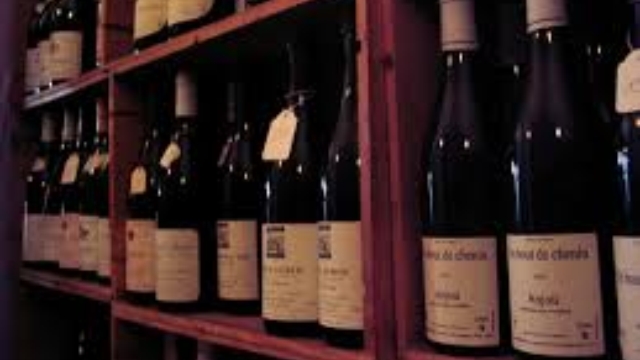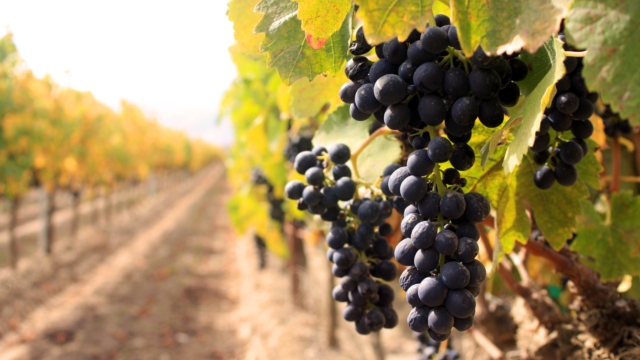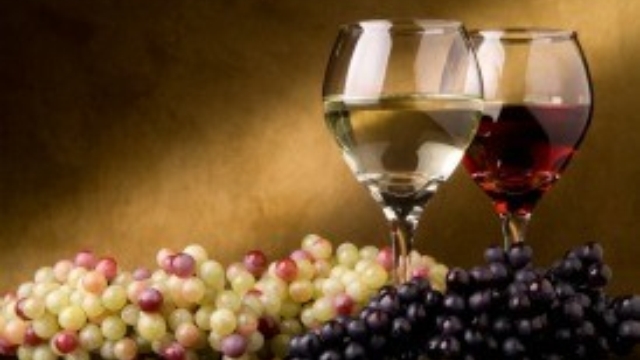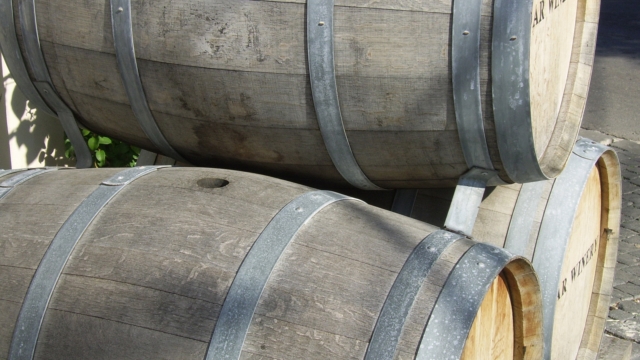That Useful Wine Site
Search, or just roll your cursor over the colored boxes farther below.click the “x” to dismiss Search-results block.




Advertisement:
Advertisement:
Quick page jumps:
(Synonyms: Barnawartha Oinot, Blanc Doux, Chevrier, Greengrape, Hunter River Riesling, Merwah, St Émillon, Semilion, Semilon, Sémillon Blanc, Sémillon Muscat)

Sémillon is a white-wine grape originating in the Bordeaux region of France, where—with Sauvignon Blanc—it has historically been a major component in the regional white-Bordeaux blends. Today, Sémillon continues to be significant in Bordeaux, though (as with all Old World regional wines) rarely as a monovarietal; it is also a major grape in Australia, as further discussed below. There are smaller plantings in most of the other major wine regions of the world, from Chile to South Africa.
Sémillon is today widely considered one of the dozen and a half or so “Noble wine grapes” of the world, though that status is almost certainly in good part derived from the amazing dessert wines (as in Château d’Yquem and other Sauternes and Barsacs) it makes, from Bordeaux to Washington State, rather than from our focus here, table wines—which is not to say that it cannot make excellent table wines, given due attention.
Sémillon is a grape shifting from the Old World to the New. Alone and even as an ingredient in blends, it is currently losing popularity in France, to the extent that the makers of the famous dessert wines have banded together to grow their own so as to assure a continuing supply. A major reason, ironically, is that both winemakers and consumers in France and indeed much of the world consider Sémillon to be lacking in greatness owing to a lack of complexity and clear distinctiveness when used in or as a table wine—but that situation is very different in Australia. Its chief role in Bordeaux has always been as a “softener” of the much more aggressive Sauvignon Blanc grape, but winemakers today can better control that without needing as much blending of mollifying grapes, hence the dwindling of interest in its homeland.
Sémillon as a monovarietal table wine is, however, now taken quite seriously in Australia, where several styles exist. Of those, the two most interesting are (to quote Wikipedia) “a complex, minerally, early picked style which has great longevity; and an equally high quality dry style, which can be released soon after vintage, as a vat- or bottle-aged example.” Those are said to be styles unique to Australia. Specimens from the Hunter Valley region, arguably the premier Australian specimens, are never oaked (but with maturity famously take on a deceiving quality of oakiness). Sémillons of the aged sort tend to taste somewhat honeyed and toasty; the younger style emphasizes fruit, tending to display citrus aromas and flavors.
(A curious conundrum will emerge if you read through the various sources quoted and linked below: the degree of acidity of Sémillon wines. It would appear that Sémillon is definitely a high-acid grape—which is exactly why it ages so long and well—and so many descriptions have it. Nonetheless, many other descriptions refer to it as low-acid—even though the same description may well, some sentences later, also refer to the grape’s high acid. One is left to ponder that anomaly, but suspects that it might be the difference between warm-climate and cool-climate growing conditions, as grapes not fully ripened tend toward distinctly higher acidity; one flag is alcohol content: Sémillon wines over perhaps 12% alcohol are probably warm-grown and less acid; wines under 12% are likely to be cool-grown and more acid.)
Factoid: As of the early 19th century, Sémillon was thought to be the most widely planted white-wine varietal in the world.
Examining reviews and competition results soon makes one thing crystal clear: not many brands of Australian Sémillons are making it into the U.S. Here, for example, is an Australian taste-off of 49 Sémillons [archived copy]; here’s another of 44 Australian Sémillons. Try to find any of them at retail in the U.S. Neither of the big wine-search engines show any but a very few. (Yes, you can find some Sémillons among the usual big-name, single-digit-price bottlings, but we’re talking about serious wine here, not plonk with a funny animal on the label). We have nonetheless managed to include a couple of Oz Sémillons, plus a couple of Argentines and a South African.
Making a final list was tough, with more likely candidates than we typically show; we hope these are, all things considered, the best nominees.
• This wine’s Wine Searcher “Reviews” page.
• This wine’s CellarTracker review pages.
• Retail offers of this wine listed by Wine Searcher.
• Retail offers of this wine listed by 1000 Corks.
• This wine’s Wine Searcher “Reviews” page.
• This wine’s CellarTracker review pages.
• Retail offers of this wine listed by Wine Searcher.
• Retail offers of this wine listed by 1000 Corks.
• This wine’s Wine Searcher “Reviews” page.
• This wine’s CellarTracker review pages.
• Retail offers of this wine listed by Wine Searcher.
• Retail offers of this wine listed by 1000 Corks.
• This wine’s Wine Searcher “Reviews” page.
CellarTracker has two separate listings for this wine:
• This wine’s CellarTracker review pages.
• This wine’s CellarTracker review pages.
• Retail offers of this wine listed by Wine Searcher.
• Retail offers of this wine listed by 1000 Corks.
• This wine’s Wine Searcher “Reviews” page.
• This wine’s CellarTracker review pages.
• Retail offers of this wine listed by Wine Searcher.
• Retail offers of this wine listed by 1000 Corks.
Our nomination is Tyrrell’s “Vat 1” Sémillon, which retails for about $50 to $67. This is not the “Museum Release” version of this famous wine.
• This wine’s Wine Searcher “Reviews” page.
• This wine’s CellarTracker pages.
• Retail offers of this wine listed by Wine Searcher.
• Retail offers of this wine listed by 1000 Corks.
Advertisement:
Advertisement:
|
|
This site is one of The Owlcroft Company family of web sites. Please click on the link (or the owl) to see a menu of our other diverse user-friendly, helpful sites. |
|
| (Note: All Owlcroft systems run on Ubuntu Linux and we heartily recommend it to everyone—click on the link for more information). | ||
|
All content copyright © 2024 The Owlcroft Company
(excepting quoted material, which is believed to be Fair Use). |
This web page is strictly compliant with the W3C (World Wide Web Consortium) Extensible HyperText Markup Language (XHTML) Protocol v1.0 (Transitional) and the W3C Cascading Style Sheets (CSS) Protocol v3 — because we care about interoperability. Click on the logos below to test us!
This page was last modified on Saturday, 30 October 2021, at 11:26 pm Pacific Time.
Some Descriptions of Sémillon Wines
“Most examples of these bottle-aged Hunter Semillons exhibit a buttercup-yellow colour, burnt toast or honey characteristics on the nose and excellent complex flavours on the palate, with a long finish and soft acid. Young Hunter Valley semillon is almost always a dry wine, usually exhibiting citrus flavours of lemon, lime or green apple. Cooler-year Hunter Semillons seem to be the most highly sought after, with some of the 1974 and 1977 vintages still drinking well.”
“Sémillon wine is loved for its full body, like Chardonnay, but with flavors closer to Pinot Gris or Sauvignon Blanc…The primary fruit flavors in Sémillon wine are lemon, apple, pear and green papaya. There’s something very waxy about the taste of Sémillon which wine writers often describe as lanolin. Depending on where Sémillon is grown it can range from being a zesty, palate-cleansing wine like Sauvignon Blanc to a rich, creamy, lemon-flavored wine like oaked Chardonnay…;Hot-Climate Sémillon: More ripe fruits, including mango, yellow peach and papaya, can be found in warm climate Sémillon. It’s not uncommon to find wines from these regions using moderate oak-aging to add buttery notes to the flavor. Hotter-climate regions include California, South Africa, Argentina, South Australia and part of Washington State. Wines will be higher alcohol with about 12-14% ABV. Cool-Climate Sémillon: When winemakers pick Sémillon less ripe, the wines have a lot more acidity and often resemble their popular cousin, Sauvignon Blanc. Citrus flavors of lemon, lime zest and grapefruit are accentuated in this style when winemakers don’t oak-age their Sémillon. A cooler climate Sémillon will also have more flower aromas. Cooler climate Sémillon wines (where grapes are picked less ripe) are commonly from Washington State, Bordeaux, Hunter Valley Australia and Western Australia. In these areas, wines will have about 10-12% ABV”
“So now you find two incarnations of Hunter Sémillon. The first might almost be deemed a sauvignon blanc substitute: it is young, unoaked, lithe and grassy and refreshing, tinted with citrus flavours, but more delicate, not as attention-seeking or as raucous as the dreaded SB. The second is aged Sémillon. More than almost any other grape, Sémillon undergoes an extraordinary alchemy as it ages. If in its infancy it is reminiscent of mown grass, with a quicksilver citrus quality, with time that grass turns to hay, the citrus softens into a rich beeswax and lanolin and out of nowhere the grape throws up a nutty, toasty edge with the smell and a rasping texture that would have you swear, absolutely swear, it had spent some time breathing through the oak of barrels. I like Sémillons when they’re caught midway between youth and age, so they still have a bit of zesty drive, but also soar with this magnificent, swooping, seemingly impossible complex transformation. Such is the texture that, blind tasting, I sometimes confuse them with Clare Valley riesling – but they don’t have the matching lime, the lilac or the acidity.”
“The reason these wines are so well regarded is the extraordinary ability of Semillon to develop beguiling bouquet as the wines mature in the bottle. There’s nothing quite like it. Young Semillon has a fat texture, but a fairly bland aroma, often described as ‘fig-like,’ and a pleasant, but short finish. Often this non-descript character is a function of Semillon’s tendency to produce massive crops. Fifteen-year-old, dry Semillons made from grapes grown on old vines, water stressed to reduce crop levels, are an entirely different story. Their bouquet becomes rich and penetrating with a toasty, ‘hazelnut-like’ character which remains on the tongue for minutes, and in the mind for years.”
“Picked early at low potential alcohol and unoaked, in their youth Hunter Valley Semillons are rather neutral, acidic white wines. With several years in the bottle, though, they undergo a metamorphosis, putting on weight and developing a delicious toasty, honeyed character that could fool you into thinking they’ve been barrel fermented. The best examples can carry on evolving for decades.”
“Unaged, dry Sémillon is a very lemony, citrusy wine. It tastes like (dare I say?) just boring white wine – neutral with some acid but not much character. Sometimes it can take on an herbal or tropical note, and can be a little like candle wax too, but it’s generally a little boring without any age. I think this wine is better when it’s been held in the bottle for a while. With a little age, Sémillon gets interesting. I’ve had a few that are a bit older and they are amazing. Boring white wine turns into something honeyed and croissant-like, and can allegedly (I haven’t experienced this particular phenomenon myself) taste like buttered toast, even if there’s been no time in an oak barrel, which is generally responsible for toast-like flavors.”
“Sémillon contributes a deep golden color to a wine, even more so if the grapes have been botrytised. With an aromatic profile that ranges from subtle fruit to floral and some spice to a bit of earthy and herbal, this particular grape does not dominate the nose, but supports the blending process with its ability to offer the rich fruit character of honeyed apricots, quince, candied peach and creamy vanilla tones. In fact, its ability to pick up and spotlight the impressionable oak influences are another draw for blending with this grape…With its lower levels of acidity, almost oily textures, more subtle aromatics and rounder profile, it is the perfect complement to the leaner lines, zesty profile and fresh acidity of Sauvignon Blanc. Sémillon also enjoys a reputation for aging well over the long haul…While lacking complexity as a young single varietal wine, with a bit of age Sémillon can take on the rich, full flavors of candied fruit, carmalized nuts and ongoing honey nuances.”
“Dry versions of semillon have a signature waxlike nose. Vanilla, citrus, grass, floral and sometimes green pepper aromas can be noticed. While usually full-bodied with a round mouth feel, it can be deceptively high-acid. Semillon found a hospitable home in the Hunter Valley of Australia, where, without any oak, it creates wines that improve over the course of a decade and can age even longer.”
“It’s a grape that sometimes tastes similar to a Sauvignon Blanc, and yet is still completely different, with brighter citrus, less grassiness, and a lighter, paler color…Most dry Semillons typically have a very pale straw color to them, nearly clear in the glass save for the slightest tint of yellow…Dry Semillons are youngish wines, so you’re not going to get an overwhelming perfume-y nose on them by any stretch of the imagination. The scents you’ll get on a Semillon will be very dry and crisp, similar to a Sauvignon Blanc but not grassy (the similarities between the wines are why they are such well-matched blending partners). You will get guava and other tropical fruits, maybe some orange or Mandarin orange even an orange cream…But dry (not dried) tropical citrus fruit is the key aroma in a Semillon wine…You’re definitely going to get a dry, sharp, citrus snap to a Semillon – more tropical fruits like the guava and some pineapple and even a Limeade flavor in there. It might start out with just a touch of sweetness too but then develop quickly into the more sour, acidic citrus fruit flavors. Don’t be afraid; the acid is a good thing. The wine should be very dry and very clean on the finish, with only the slightest hint of an aftertaste too.”
“Wines dominated by semillon may lack much youthful aroma, but have fairly full body and tend to be low in acidity, even ‘oily’ or ‘fat’ at times. Semillon also has an affinity for oak, accentuating subtleties such as ‘toast’ and ‘smoke’ that emanate from wines’ ‘spice’ rather than its ‘main ingredient’, but nonetheless adding complexity. This is the flavor profile of a supporting role grape, rather than a star, and most winemakers use semillon in blends, if at all. Semillon is the soft, subtle, rich Yin to balance the Yang of sauvignon blanc, which can be aromatically aggressive and acidic. Semillon even works well when blended with that notoriously standoffish loner, chardonnay, providing weight and richness without diverting aromatic delicacy.”
“The best Hunter Valley Semillons have such high acidity that they used to be referred to as Hunter Valley Riesling, although there seems to be less confusion these days. These wines are some of the longest living whites in the world…Intensely structured Semillon wines may be barrel aged, while fresher examples are typically blended with Sauvignon Blanc and fermented in stainless steel.”
“In Australia’s Hunter Valley, say, it’s at its most distinctive – almost like a riesling, as indeed it used to be known…Sémillon from the Barossa is richer and fatter – more pineapple than lime – and perhaps more to your taste if you’re a chardonnay drinker…And in the Margaret River, Sémillon can be as green and grassy as the sauvignon with which it’s generally blended, a synthesis that oddly creates a wine that’s riper than both.”
“To him, the failure is in comprehending what great Semillon requires: poor, gravelly soils (in Livermore, as in Graves); serious winemaking; and that willingness to wait…But there’s no real reason for our Semillon betrayal aside from the whims of fashion. When grown carefully and picked with some green flavors amid the typical fig and honey, it shines. The gastronomic potential is profound. It’s less obvious than Chardonnay, less strident than Sauvignon Blanc.”
“Australia is the best known wine region where Semillon excels. Among the prime spots for Australian Semillon are South Australia’s Barossa Valley and the Hunter Valley in New South Wales, where the unoaked style is favored. The intriguing thing about mature Hunter Semillon is that it smells and tastes like it had been aged in oak, though the wine never touched wood. A similar depth and structure are obtained in the Adelaide Hills of South Australia and Western Australia’s Margaret River by blending Semillon with a little Sauvignon Blanc…With young Semillon you often get crossed signals that can put off the consumer. Aromatics are scant and the wine tends toward fatness, or a ripe oily texture…With bottle age, Australian Semillon becomes a different animal, often described as ‘honey and toast.’ Mature Semillon’s fruit profile is riper, more mature, leaning away from green apple and more toward figs, bread dough, straw and a toasted component that can easily be confused with the scent of toasted oak barrels…Youthful Semillon appeals with hints--though sometimes muted ones—of lemon grass and lemon peel, crisp green apples, lime juice, freshly mown grass, vanilla, and refreshing vibrant acidity.”